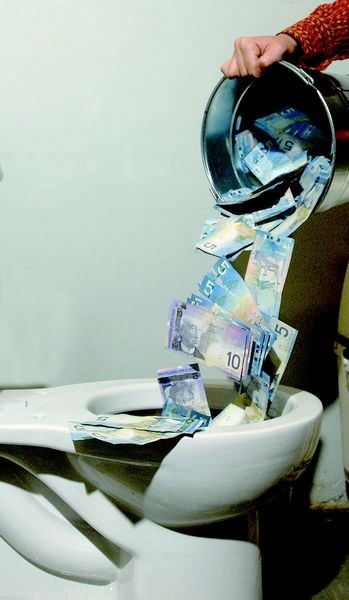B.C.'s municipal spending is getting out of hand and the worst offender is Prince George, according to a study by the national lobby group for business interests.
The Canadian Federation of Independent Business (CFIB) reported on its third annual municipal spending watch study today stating that municipal operating spending growth in B.C. continues to outpace population and inflation growth, now by a two-to-one margin.
If "excess spending" in Prince George had been eliminated, states the report, the 2008 tax bill for the average family of four would have been reduced by $1,464.
The estimation is based on numbers from 2008, the most recent data available.
"This is a wake-up call to taxpayers," said Laura Jones, CFIB's vice president for Western Canada.
"Many municipalities perpetuate the myth that they are hard done by when it comes to revenues. The reality is that they are addicted to the overspending. Its grossly unfair to taxpayers who suffer tax and fee increases that outstrip their pay increases."
Municipal spokespeople were asked for comment but none were provided by deadline.
It's not all bad news for Prince George's municipal government, however. The CFIB only weeks ago cited B.C.'s northern capital as being third best in the province and 17th best in all of Canada for its entrepreneurial climate.
This was a 12-category calculation, which included a component devoted to the ways local government affects business (Prince George scored 65 out of 100, in the top 22 among Canadian cities).
In the wake of the latest report, the CFIB is urging the provincial government to establish an independent municipal auditor general position to keep tabs on the budgeting by local governments, and improve transparency.
"To preserve the long-term health of local communities, it is essential that future spending increases be controlled to ensure that per capita spending does not grow excessively over time, to the detriment of businesses and residents across the province," states the report.
The CFIB created a calculation they call the Fiscal Sustainability Gap and Prince George has not only scored poorly in each of the last three years, but is getting worse and it is, according to the CFIB's estimation, costing average taxpayers.
"Between 2000 and 2008, Prince George's operating spending has grown by 48 per cent," said the report, "while population and inflation growth was only 12.4 per cent... an increasing Fiscal Sustainability Gap shows continued overspending."
The report showed that Prince George's government operating expenditures grew by 48 per cent from 2000-2008. This was by no means the worst increase in B.C., in fact it was the fifth smallest increase among cities bigger than 25,000 people.
The population-inflation combination was 12.4 per cent, however, which was the bottom of the province.
The CFIB suggested a list of actions for municipalities to bring spending down.
The top of the list was to bring their wage and benefits structure more in line with private sector compensation totals.
Next was to clearly define each city's core services and invest only in those.
Spending should be fixed to population and inflation numbers, the group said.
Prince George businesses indicated local government was good to be a subscriber to the Bizpal program which cuts down on regulatory work, one of the better places in Canada for red tape and regulations (Top 25), but alarmingly low on the topic of government sensitivity to local business and very low (23rd worst) in the "cost of local government" category.
Although it was not one of the indicators in the Fiscal Sustainability Gap calculation, the CFIB also reported the per capita spending of each city, although they did not mention relative taxes (cities also spend grant money they get from other levels of government, return on investments, grants from private funding sources, etc., not just taxes). For Prince George in 2008, the per capita spending was $1,521 or a 53.9 per cent increase from 2000 - one of the Top 8 biggest jumps among B.C.'s major cities.


